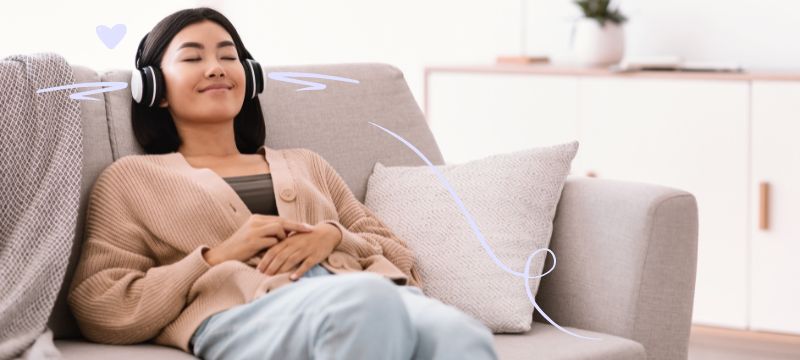5 Ways to Soothe Sensory Overwhelm as a Neurodivergent Person

Interoceptive awareness is off for many neurodivergents. Here’s how to fix bad vibes and soothe sensory overwhelm.

What is interoception?
Interoception is the sense that helps you understand your internal bodily sensations.
It’s how you perceive feelings like hunger, thirst, your heartbeat, and needing to go to the toilet.
This sense allows your brain to stay tuned to what’s happening inside you.
It’s how your body communicates with your mind about its needs and conditions.
Interoception helps regulate bodily functions and emotional responses. Which guide us to take action when necessary.
Like drinking water when thirsty or eating when hungry.
In essence, interoception is our internal awareness system. It links body and mind for overall well-being.
Why is interoception hard for neurodivergent people?
For neurodivergent people, interoceptive awareness can be a complex challenge.
People who are autistic, ADHD or who have sensory processing disorders, may find internal cues difficult to process.
You might struggle to accurately recognise and interpret sensations like:
- hunger,
- fatigue,
- pain, or
- emotional states
due to differences in sensory processing and neural connectivity.

Hypersensitivity vs Hyposensitivity
Some neurodivergent people might feel things more intensely. Like having heightened sensory sensitivities.
This is hypersensitivity.
This can make common sensations feel overwhelming. Making it hard to tell what’s really going on inside.
On the other hand, some people might have diminished sensory sensitivities and not feel things as much.
This is hyposensitivity.
You might miss out on important cues your body gives you.
This can lead to difficulties in responding appropriately to bodily needs. Such as not recognising when you’re hungry or not feeling the urge to drink when thirsty.
Fuzzy interoception can also lead to challenges in emotional regulation.
Like not understanding when you’re feeling anxious or happy. Which might also hinder effective communication in social contexts.
This means navigating your unique sensory experience requires understanding, patience, and personalised strategies.
What is sensory overwhelm?

Sensory overwhelm is when your senses—like sight, sound, touch, and smell—become too much for your brain to handle at once.
It’s like getting a lot of messages all at the same time, and your brain has a hard time sorting them out.
This can happen to anyone, but it’s especially common in neurodivergent people.
Your brain might process sensory information in unique ways. Either becoming super sensitive or not as responsive as usual.
Sensory overwhelm can occur because your brain might not filter out unnecessary information.
So, everyday sights, sounds, or textures that might not bother someone else can feel like a lot to you. It’s like your brain’s volume knob is turned up too high.
This can lead to stress, anxiety, and even meltdowns, as your brain struggles to manage the flood of sensory input.
Finding ways to cope with sensory overwhelm can help you manage these challenges and feel more comfortable. Such as:
- using noise-cancelling headphones
- finding quiet spaces
- listening to meditones®, or
- using weighted blankets.

The link between sensory overwhelm and interoception
The connection between sensory overwhelm and interoception lies in your brain. And how you process both external and internal sensations.
When sensory processing is affected (as it often is in neurodivergents), it can impact your ability to accurately perceive these sensations.
For example, sensory overwhelm happens when your external senses like touch, sight, and sound become too intense.
This makes it hard for your brain to handle all the information at once.
And when your senses get overwhelmed? It can make it even harder to tune into your internal sensations, like hunger or tiredness.
It’s like trying to listen to a soft song in a noisy room. The noise makes it hard to hear the song clearly.

This happens because your brain has limited resources.
And when it’s busy processing overwhelming sensory inputs? It might not have enough attention left to pick up on your internal cues.
On the flip side, when your sensory sensitivities are lowered, you might not notice these internal cues as readily.
This can lead to challenges in recognising when you’re hungry, tired, or even anxious. Which are important signals for taking care of yourself.
So, the relationship between sensory overwhelm and interoception is a dance between how your brain handles external and internal information.
This in turn impacts how you experience and navigate the world around you.
Why improving interoception is important for neurodivergent people
Improving interoception can be especially useful for neurodivergent people. This is due to differences in sensory processing.
By honing interoceptive skills, you can:
- better manage sensory input before you become overwhelmed
- identify and express your feelings more accurately
- improve emotional regulation
It’s like having an inner compass that guides you toward better self-understanding and consistent self-care. Which leads to an improved quality of life.
However, sometimes enhancing interoception is just too difficult. So a framework for determining what’s happening when you feel bad can help.
The problem with the HALT method
A lot of neurodivergent people use the HALT method to identify potential stressors. HALT stands for Hungry Angry Lonely Tired.
But we feel like this doesn’t cover the full range of potential sensory overwhelm.
Additionally, HALT uses emotions like Anger and Loneliness as potential risks for stress.
But emotions are the stories we tell ourselves about our bodily sensations.
Which means emotional identification still requires interoceptive awareness. Which we know neurodivergent people struggle with.
Like, you may think you’re feeling angry but actually you’re hungry.
In order to effectively triage and treat neurodivergent overwhelm? We use the 5T method.
An alternative to HALT

Our neurodivergent co-founder, Tahlee, was struggling with interoception. But the HALT method wasn’t working for her.
So she came up with the 5T method to help soothe sensory overwhelm.
5T stands for Temperature, Toilet, Table, Time Out, Treat.
It works best if you can go through each step, one after the other, to help identify and soothe pain points.
(Any health information is provided for general informational and educational purposes only and is not a substitute for professional medical advice, diagnosis, or treatment.)
1. Temperature
Perhaps you’re too hot/cold. What is the weather like at the moment? Is it a hot sunny day? Or cold and rainy? What do you notice the people around you wearing?
If you suspect you’re too hot, remove a layer of clothing. Or add a layer of clothing if you think you might be cold.
You could also ask someone trusted nearby to feel the skin on your arm. Does your skin feel hot or cold? Adjust accordingly.
2. Toilet
Perhaps you need to pee/poop. Go do that.
3. Table
Perhaps you’re hungry/thirsty. Slowly sip a glass of water & eat a plain snack like some crackers, a piece of fruit or some nuts.
4. Time out
Perhaps you need rest. Lie in a quiet dark room for 20 minutes.
If you’ve gone through each step and still feel bad…
5. Treat
Perhaps you are sick or in pain. You may need to see a doctor, take a painkiller, or ask someone for help.
You could also keep a journal to track your bodily sensations, emotions, and responses. This can provide valuable insights over time.
Takeaway
Improving interoception skills can be a helpful journey for neurodivergents.
Gradually understanding how different sensory inputs feel can improve your ability to process them.
Identifying patterns and triggers can aid in better self-care. And using the 5T method can help you soothe sensory overwhelm.
Remember, like any skill, improving interoception takes patience and practice. But it can make a meaningful difference in your overall well-being.
Soothe sensory overwhelm with the Restful app. Download for free on Google Play or the App Store today!